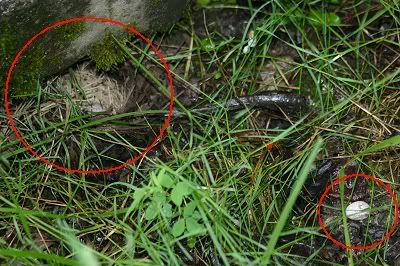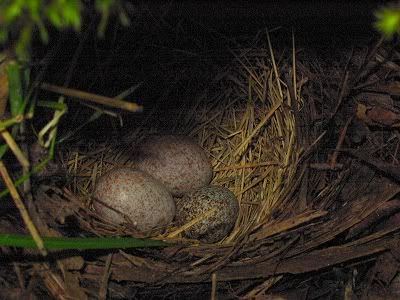Post by Gord on Jun 16, 2006 13:06:47 GMT -8
In my travels last week, I came across this spotted towhee nest. This turned out to be more of an interesting find, as there was a towhee egg a foot or two away from the nest. The circle on the left is the nest, and the one on the right is the egg.

On closer inspection, the wayward egg had a hole in it. A beak sized hole to be more precise.

As I went to take a peek at the nest, I had a good idea what Id find.

Yup! That smaller egg there is a brown-headed cowbird egg.
What probably happened is the female cowbird observed the towhee building its nest and kept an eye on it waiting for the towhee to start laying eggs. Once she did, the cowbird moved in. Either before or after laying her own egg, the cowbird removed one of the towhee's eggs. A cowbird female can lay an eggs very quickly (1-2 minutes) while other small birds can take up to an hour or more to lay an egg. This is to ensure she can lay an egg before the rightful owner of the nest gets back and starts laying down the law.
Now, the towhee will incubate the cowbird egg and feed the young one when it hatches. In some species of bird, the cowbird young out competes with the host bird's young and the host's young end up dying. This is because cowbird eggs generally hatch a few days sooner than the host birds' and that the cowbird young is bigger than the host bird (vireo, warbler etc). In my readings, I found out that towhees actually have been noted to be feeding a cowbird young as well as their own. Perhaps their size helps compete when little birds cannot, or the adult towhees manage to find enough food to feed the voracious cowbird and its own young.
Interesting life cycle a brown-headed cowbird has! Slightly distasteful, but that's how it works.

On closer inspection, the wayward egg had a hole in it. A beak sized hole to be more precise.

As I went to take a peek at the nest, I had a good idea what Id find.

Yup! That smaller egg there is a brown-headed cowbird egg.
What probably happened is the female cowbird observed the towhee building its nest and kept an eye on it waiting for the towhee to start laying eggs. Once she did, the cowbird moved in. Either before or after laying her own egg, the cowbird removed one of the towhee's eggs. A cowbird female can lay an eggs very quickly (1-2 minutes) while other small birds can take up to an hour or more to lay an egg. This is to ensure she can lay an egg before the rightful owner of the nest gets back and starts laying down the law.
Now, the towhee will incubate the cowbird egg and feed the young one when it hatches. In some species of bird, the cowbird young out competes with the host bird's young and the host's young end up dying. This is because cowbird eggs generally hatch a few days sooner than the host birds' and that the cowbird young is bigger than the host bird (vireo, warbler etc). In my readings, I found out that towhees actually have been noted to be feeding a cowbird young as well as their own. Perhaps their size helps compete when little birds cannot, or the adult towhees manage to find enough food to feed the voracious cowbird and its own young.
Interesting life cycle a brown-headed cowbird has! Slightly distasteful, but that's how it works.

 Probably thanks to a jay or crow. Bummer!
Probably thanks to a jay or crow. Bummer!